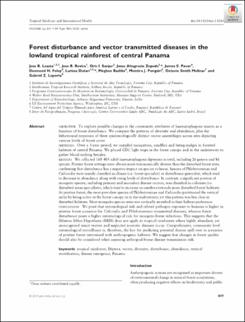| dc.contributor.author | Loaiza, Jose R. | |
| dc.contributor.author | Rovira, Jose R. | |
| dc.contributor.author | Sanjur, Oris I. | |
| dc.contributor.author | Altagracia Zepeda, Jesus | |
| dc.contributor.author | Pecor, James E. | |
| dc.contributor.author | Foley, Desmond H. | |
| dc.contributor.author | Dutari, Larissa | |
| dc.contributor.author | Radtke, Meghan | |
| dc.contributor.author | Pongsiri, Montira J. | |
| dc.contributor.author | Smith Molinar, Octavio | |
| dc.contributor.author | Laporta, Gabriel Z. | |
| dc.date.accessioned | 2020-07-04T07:58:01Z | |
| dc.date.available | 2020-07-04T07:58:01Z | |
| dc.date.issued | 2019-07-07 | |
| dc.identifier.other | https://doi.org/10.1111/tmi.13244 | |
| dc.identifier.uri | http://repositorio-indicasat.org.pa/handle/123456789/172 | |
| dc.description | objective To explore possible changes in the community attributes of haematophagous insects as afunction of forest disturbance. We compare the patterns of diversity and abundance, plus thebehavioural responses of three epidemiologically distinct vector assemblages across sites depictingvarious levels of forest cover.methods Over a 3-year period, we sampled mosquitoes, sandflies and biting-midges in forestedhabitats of central Panama. We placed CDC light traps in the forest canopy and in the understorey togather blood-seeking females.results We collected 168 405 adult haematophagous dipterans in total, including 26 genera and 86species. Pristine forest settings were always more taxonomically diverse than the disturbed forest sites,confirming that disturbance has a negative impact on species richness. Species of Phlebotominae andCulicoides were mainly classified as climax (i.e. forest specialist) or disturbance-generalist, which tendto decrease in abundance along with rising levels of disturbance. In contrast, a significant portion ofmosquito species, including primary and secondary disease vectors, was classified as colonists (i.e.disturbed-areas specialists), which tend to increase in numbers towards more disturbed forest habitats.At pristine forest, the most prevalent species of Phlebotominae and Culicoides partitioned the verticalniche by being active at the forest canopy or in the understorey; yet this pattern was less clear indisturbed habitats. Most mosquito species were not vertically stratified in their habitat preference.conclusion We posit that entomological risk and related pathogen exposure to humans is higher inpristine forest scenarios for Culicoides and Phlebotominae transmitted diseases, whereas forestdisturbance poses a higher entomological risk for mosquito-borne infections. This suggests that theDilution Effect Hypothesis (DEH) does not apply in tropical rainforests where highly abundant, yetunrecognised insect vectors and neglected zoonotic diseases occur. Comprehensive, community levelentomological surveillance is, therefore, the key for predicting potential disease spill over in scenariosof pristine forest intermixed with anthropogenic habitats. We suggest that changes in forest qualityshould also be considered when assessing arthropod-borne disease transmission risk. | en_US |
| dc.description.abstract | objective To explore possible changes in the community attributes of haematophagous insects as afunction of forest disturbance. We compare the patterns of diversity and abundance, plus thebehavioural responses of three epidemiologically distinct vector assemblages across sites depictingvarious levels of forest cover.methods Over a 3-year period, we sampled mosquitoes, sandflies and biting-midges in forestedhabitats of central Panama. We placed CDC light traps in the forest canopy and in the understorey togather blood-seeking females.results We collected 168 405 adult haematophagous dipterans in total, including 26 genera and 86species. Pristine forest settings were always more taxonomically diverse than the disturbed forest sites,confirming that disturbance has a negative impact on species richness. Species of Phlebotominae andCulicoides were mainly classified as climax (i.e. forest specialist) or disturbance-generalist, which tendto decrease in abundance along with rising levels of disturbance. In contrast, a significant portion ofmosquito species, including primary and secondary disease vectors, was classified as colonists (i.e.disturbed-areas specialists), which tend to increase in numbers towards more disturbed forest habitats.At pristine forest, the most prevalent species of Phlebotominae and Culicoides partitioned the verticalniche by being active at the forest canopy or in the understorey; yet this pattern was less clear indisturbed habitats. Most mosquito species were not vertically stratified in their habitat preference.conclusion We posit that entomological risk and related pathogen exposure to humans is higher inpristine forest scenarios for Culicoides and Phlebotominae transmitted diseases, whereas forestdisturbance poses a higher entomological risk for mosquito-borne infections. This suggests that theDilution Effect Hypothesis (DEH) does not apply in tropical rainforests where highly abundant, yetunrecognised insect vectors and neglected zoonotic diseases occur. Comprehensive, community levelentomological surveillance is, therefore, the key for predicting potential disease spill over in scenariosof pristine forest intermixed with anthropogenic habitats. We suggest that changes in forest qualityshould also be considered when assessing arthropod-borne disease transmission risk. | en_US |
| dc.language.iso | eng | en_US |
| dc.rights | info:eu-repo/semantics/openAccess | |
| dc.rights | https://creativecommons.org/licenses/by-nc-sa/4.0/ | |
| dc.subject | ropical rainforest | en_US |
| dc.subject | Diptera | en_US |
| dc.subject | vector | en_US |
| dc.subject | diversity | en_US |
| dc.subject | disturbance | en_US |
| dc.subject | abundance | en_US |
| dc.subject | vertical stratification | en_US |
| dc.subject | disease emergence | en_US |
| dc.subject | Panama | en_US |
| dc.title | Forest disturbance and vector transmitted diseases in thelowland tropical rainforest of central Panama | en_US |
| dc.type | info:eu-repo/semantics/article | en_US |
| dc.type | info:eu-repo/semantics/publishedVersion | |

